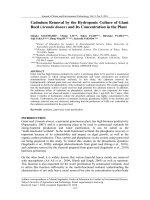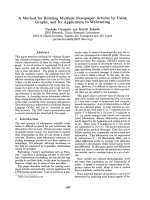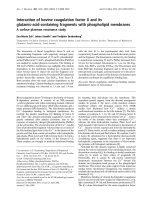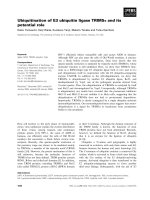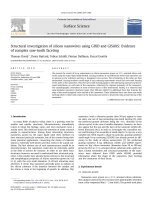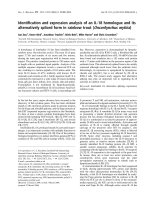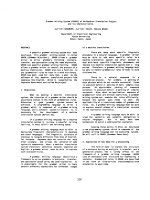MODELING OF OPENCAST MINES USING SURPAC AND ITS OPTIMIZATION
Bạn đang xem bản rút gọn của tài liệu. Xem và tải ngay bản đầy đủ của tài liệu tại đây (1.79 MB, 46 trang )
MODELING OF OPENCAST MINES USING SURPAC
AND ITS OPTIMIZATION
A THESIS IS SUBMITTED IN PARTIAL FULFILLMENT OF THE
REQUIREMENTS FOR THE DEGREE OF
BACHELOR OF TECHNOLOGY
IN
MINING ENGINEERING
By
Harshit Agrawal
(Roll No 108MN048)
Department of Mining Engineering
National Institute of Technology
Rourkela – 769008, India
April, 2012
MODELING OF OPENCAST MINES USING SURPAC
AND ITS OPTIMIZATION
THESIS IS SUBMITTED IN PARTIAL FULFILLMENT OF THE
REQUIREMENTS FOR THE DEGREE OF
BACHELOR OF TECHNOLOGY
IN
MINING ENGINEERING
By:
Harshit Agrawal
(Roll No. - 108MN048)
Under the guidance of
Prof. B. K. Pal
Department of Mining Engineering
National Institute of Technology
Rourkela – 769008, India
April, 2012
National Institute of Technology, Rourkela-769008 Page I
Department of Mining Engineering
National Institute of Technology, Rourkela-769008, India
CERTIFICATE
This is certify that the thesis entitled “Modeling of opencast mines using Surpac and its
optimization” submitted by Mr. Harshit Agrawal (Roll No-108MN048) in partial fulfillment
of the requirements for the award of Bachelor of Technology Degree in Mining Engineering at
Nationa Institute of Technology, Rourkela is an authentic work carried out by him under my
supervision and guidance.
To the best of my knowledge, the matter embodied in the thesis has not been submitted to any
other university/ Institute for award of any Degree.
Dr. B. K. Pal
Professor
Dept. o Mining Engineering
National Institute of Technology
Rourkela-769008
National Institute of Technology, Rourkela-769008 Page II
Department of Mining Engineering
National Institute of Technology, Rourkela-769008, India
ACKNOWLEDGEMENT
I would like to articulate my deep gratitude to my project guide Dr. B. K. Pal, Professor, who has
always been a source of motivation for carrying out the project. His constant inspiration and ideas
have helped me in shaping this project. I am thankful to him for giving his valuable time despite
his busy schedule for completion of my project.
A word of thanks goes to the Head of the department for allowing me to use department facilities
beyond office hours and to all the Faculty, Staff’s and Students of Department of Mining
Engineering who have helped me for carrying out my work.
I would especially like to thank Dr. S. Chatterjee for giving his valuable time helping me through
the softwares, without whose support this project could not have been completed in time.
I would like to express my gratitude to management of Sail- Barsua iron ore mine for giving
helping us and providing with necessary data, and to all those authors I have mentioned in
reference section for giving shape to my thoughts through their path breaking endeavors. Last but
not the least I would like to thank my friends and family for supporting me in every possible way
while carrying out this project work.
Harshit Agrawal
Dept. of Mining Engineering,
Bational Institute of Technology,
Rourkela-769008, India
National Institute of Technology, Rourkela-769008 Page III
Department of Mining Engineering
National Institute of Technology, Rourkela-769008, India
ABSTRACT
In this developing world, the demand for raw materials is increasing at a steady rate, in order to
bridge the gap between supply and demand, technological advancement and automation in
production method is needed. Since the raw materials are non-replenishable in nature and have
took millions of years in their formation, so these resources should be judiciously used with
maximum extraction level and aiming for zero mining waste, while adhering to all safety and
regulatory norms.
In this project, an effort have been made to estimate the resource using Surpac software for ore
modeling and optimization algorithm are used for optimizing the shape of the pit and in ultimate
pit design to ensure maximum extraction of the deposit.
If the available mineral resources are not properly utilized then the cost of production will
increase and hence company may lose in this competitive environment. So to ensure that
efficient utilization of available resources in terms of shovels and dumpers and other face
machinery available, a C++ program have been developed which can dynamically allocate the
dumper to the nearest available shovel obeying various constraints to ensure that the production
target is reached and the process is fully optimized.
Keywords: Modeling of deposit, Open Pit optimization, Ant colony optimization.
National Institute of Technology, Rourkela-769008 Page IV
CONTENTS
Sr. No Description Page no.
CERTIFICATE I
ACKNOWLEDGEMENT II
ABSTRACT III
CONTENTS IV
LIST OF FIGURES V
CHAPTERS
1.
Introduction
1.0 Introduction
1.1 Problems in pit optimization
1.2 Significance of project
1.3 Scope of work
1.4 Objective of project
1
2
3
3
4
4
2.
Literature Review
2.0 Introduction
6
7
3.
Methodology
3.0 Introduction
3.1 Stage 1- Modeling of deposit using Surpac
3.2 Stage 2- Optimization using minimum cut algorithm
3.2.1 Minimum Cut algorithm
3.3 Stage 3- Dynamic truck dispatch algorithm based on Ant
colony optimization.
3.3.1 Ant colony optimization
3.3.2 Vehicle Routing problem using Ant colony optimization
1
0
11
13
15
15
17
18
19
4.
Case Study: Results and Discussions
4.0 Introduction
4.1 Results and Discussions
4.1.1 Modeling of deposit
4.1.2 Optimization using minimum cut algorithm
4.1.3 Generation of algorithm
2
3
24
25
25
30
31
5.
Conclusion
5.0 Introduction
34
35
References 37
National Institute of Technology, Rourkela-769008 Page V
List of Figures
Figure No. Figure Description
Figure 1
Inter-relationship of multiple parameters involved in open pit optimization
Figure 2 Blocks to be removed to maintain slope angle and pit shape.
Figure 3
Analogy between ant colony behavior and open pit mining
Figure 4
Lenticular shape iron ore deposit of SAIL Barsua- Taldih-Kalta
Figure 5
Geological database of borehole information of Kalta area.
Figure 6 Ore string showing sections of the entire deposit.
Figure 7 Normal variogram at 0
o
dip and 0
o
azimuth with 22.5
o
spread
Figure 8 Normal variogram at 0
o
dip and 45
o
azimuth with 22.5
o
spread
Figure 9 Normal variogram at 0
o
dip and 90
o
azimuth with 22.5
o
spread
Figure 10
Normal variogram at 0
o
dip and 135
o
azimuth with 22.5
o
spread
Figure 11
Normal variogram at -90
o
dip and 0
o
azimuth with 22.5
o
spread
Figure 12 Solid model of the deposit
Figure 13 Constraint block model in upside down view showing extent of deposit
Figure 14
Vertical section of the pit layout
Figure 15
The discounted cash flow obtained for 6 years.
Figure16
Flowchart for generation of C++ program
.
National Institute of Technology, Rourkela-769008 Page 1
CHAPTER- 1
INTRODUCTION
National Institute of Technology, Rourkela-769008 Page 2
Chapter -1
Introduction
1.0 Introduction
The magnanimous growth and ever increasing demand of finished products have pressurized the
mother industry (mining) to supply raw materials to meet the increased demand for growth and
sustainable development of the society. These materials can be extracted from the earth crust by
any of the two methods of mining i.e., surface mining methods and underground mining
methods. Surface mining operations can be classified into open pit, opencast, strip, alluvial and
in-situ mining, depending on method of mining being considered (Hartman, 1987). Open-pit
mining is a method of developing and exploiting the deposit by making a void in the surface,
also known as pit and developing it sequentially to extract the ores. It starts off with a small pit
and gradually develops with the lapse of time in a pre-planned manner to take the final shape of
pit called as ultimate pit which includes the initial void by which the deposit was attacked.
Opencast mining is the advancement in the open pit mining methods, developed due to the acute
shortage of granted lease hold area where the overburden can be piled for future reclamation
purposes. In open-cast mining method, after all the ores in a particular area have been mined the
overburden materials are dumped in-pit in those extracted area instead of dumping it in
overburden pile within the lease hold area outside the pit. This has proved to be cost effective
and acquires lesser land area and continuous reclamation work is also ensured. At present
opencast mining has larger share of total ore production in India, owing to the technological
advancement due to availability of heavy earth moving machines (HEMMs) which has increased
the rate of production while ensuring safety and requires lesser manpower. The increased rate of
operation facilitates lesser development time.
National Institute of Technology, Rourkela-769008 Page 3
1.1 Problems in pit optimization
Opencast mine planning is a multi-parameter optimization problem which requires simultaneous
solution (Sevim & Lei, 1998). The parameters involved in open pit production planning are inter-
related hence if one parameter is affected it affects all other related parameters, so without
ascertaining the value of one parameter the next parameter cannot be ascertained (Figure 1).
Mine life is determined as the probable time required to mine all pits present in ultimate pit limit
(UPL) design, in a proper sequence in order to ensure maximum profit. In order to maximize
profit, a cut-off grade is determined based on factors like, market price of finished
metal/processed ore, mining and processing cost, overhead charges like royalty, compensation,
etc. Cut-off grade must be fixed during planning stage as it will be the driving factor in
determining block economic value (BEVs), based on the BEVs ultimate pit is determined
making use of various graph closure algorithms available like minimum cut algorithm, and
subsequently production schedule is developed by analyzing various pushback designs in order
to optimize the sequence by hit and trial method keeping in mind annual targets to be achieved,
final mining sequence is one which give maximum economic return subjected to all operational
constraints (Sevim & Lei, 1998).
1.2 Significance of project
Manual method of open pit mine planning and design require tedious work by planning team in
order to define ore boundaries, defining mine configurations in sections based on available
economic and technical information. This method was labor intensive, prone to error and time
consuming, moreover it cannot be applied to large open pit mines with millions of blocks.
Hence, it was one of the most important topics for researchers.
National Institute of Technology, Rourkela-769008 Page 4
Last 40 years have seen a tremendous advancement in the field of computer application and
numerical modeling and its increased use in mining industry. With the evolvement of new
software’s incorporating geostatistics based modeling of pit like solid modeling, 3D block
modeling, etc. and development of various optimization algorithm like branch and bound
algorithm, minimum cut algorithm, and the most widely used Lerchs- Grossmann 3D algorithm
(Lerchs & Grossmann, 1965) have helped mine planners in developing mine plans which are
accurate and reliable. Benefit of using these algorithms are that they are simple to formulate and
use, requires lesser computational time and are user friendly, i.e. they can be customized as per
users need and can incorporate real time complexities like mining constraints, working slope
angle, time value of money, etc. (Dowd & Onur, 1993). With the advancements in optimization
algorithms even low grade deposits can be mined successfully which earlier was not possible.
1.3 Scope of work
With the gradual technological developments mining industry is seeking for automation of their
operations in order to meet the increased demand from society. The project aims at providing an
Cut-Off
Grade
Mine Life
Production
Scheduling
Ultimate pit
limit
Mining and
processing cost
Production
rate
Figure
1:
Inter
-
relationship
of multiple parameters
involved
in
open pit
optimization
(Sevim & Lei 1998).
National Institute of Technology, Rourkela-769008 Page 5
insight of how software’s can be helpful in reserve determination and can be beneficial in real
time mine planning and production scheduling. Use of software have made calculations easy for
various parameters like calculations related to life of the mine, production planning, long term
and short term planning, etc. This can be helpful to top management people as resources can be
easily modeled and are easy to view and analyze and hence steps can be taken for ensuring
steady production.
1.4 Objective of project
In recent years, mining industry has undergone wide scale mechanization in order to ensure
higher production while ensuring safety of its workers and to meet long term production goal at
sustainable rate. Proper planning of reserve based on mathematical analysis of available data is
need of the hour. The fleet deployed should be optimally used in order to minimize operating and
mining cost and to meet production target. With evolvement of computer software and
optimization algorithms, mining industry are seeking the analysis done by these software to plan
their mine in most optimized and accurate way to compete with global players.
The objective of the project is to model the deposit using Surpac and provide the pit optimization
sequence by generation of a number of time dependent push back design. It also aims at
developing a C++ program which will facilitate dynamic dumper allocations to shovels based on
real time monitoring data being continuously fed to the program. It aims at reducing idle time of
both shovels and dumpers and would facilitate the achievement of target of production while
being cost competitive.
National Institute of Technology, Rourkela-769008 Page 6
CHAPTER-2
LITERATURE REVIEW
National Institute of Technology, Rourkela-769008 Page 7
Chapter- 2
Literature Review
2.0 Introduction
An extensive literature review was carried out to find various approaches which researchers have
used in past in field of open pit optimization and automation in truck dispatch system. In this
thesis, developments in the field of Ant colony optimization for truck allocation have been
widely reviewed.
Mueller 1977, proposed a model based on dispatcher which keep track of the status and position
of the equipment in the pit and guides the decision making process. The main components of the
dispatcher are shovels and dumpers which are represented by a block. The decision for
dispatching the dumper is taken once it has dumped its load either in dump site or in crusher
plant. The dispatcher updates the value and calculates various response functions to allocate its
new assignment.
Wilke & Reimer 1977, proposed a linear programming model for short term production
scheduling for an iron ore mines.
Jordi & Currin 1979, proposed a model to optimize Net present Value (NPV), net profit and
production output.
Zhang et al. 1986, proposed a new method of optimization that combined inventory theory,
dynamic programming, computer simulation involving interactive technique to calculate
production scheduling of an open pit mines.
Dagdelen & Johnson 1986, developed application of Lagrangian parameterization for optimizing
production planning. This method involved use of ultimate pit limit algorithms in order to
generate block models having different block economic values to develop production schedules.
National Institute of Technology, Rourkela-769008 Page 8
Whittle 1990, has done extensive work using meta-heuristic approach and have developed an
algorithm which is most widely used throughout for open pit optimization.
Achireko & Frimpong 1996, proposed an algorithm which can utilize the random field properties
associated with grade of ore, product price, etc. They used artificial neural network to classify
blocks into classes on the basis of their conditioned value after modeling block characteristic
using conditional simulation. Error back propagation algorithm was then used to optimize the
ultimate pit limit by minimizing desired errors in multiplayer perception under pit wall slope
constraints.
Sevim & Lei 1998, developed a method which had the capability to determine cut-off grade,
mining and processing rate, mining sequence, mine life and the ultimate pit limit design.
Ramazan & Dagdelen 1998
, proposed a new algorithm which has the capability to develop push
backs of minimum stripping ratios.
Ronson 2001, has done an extensive study on various software available for open pit mine
planning and scheduling. He had made an attempt in outlining the various modules available for
particular work and had also made a comparative study on which module of particular software
is user friendly and easy to learn and the accuracy of results obtained from them. A detailed
review of mining softwares is available like, Minex, Vulcan, Surpac, Datamine, etc.
Bissiri 2003, have tried to simulate the social insect model like ant colony system into mining
problem and have made an analogy between the two processes. He had tried to formulate an
agent based truck dispatch system based on ant colony optimization in which he had calculated
stimulus of shovels, threshold of dumpers and response value of shovels for a particular dumper
to facilitate real time allocation of dumpers to shovels in day-to-day planning and production
scheduling in order to meet the target.
National Institute of Technology, Rourkela-769008 Page 9
Dorigo et. al. 2004
, in his on Ant colony optimization has provided an analogy between real ant
colony and artificial ants (shovel-dumper combination) and minimum cost path and provides a
metaheuristic approach to ant colony based optimization. They have also shown its application in
vehicle routing problem and in scheduling problems.
Ramazan et al. 2005, proposed a new production scheduling optimization technique based on
fundamental tree algorithm while making an attempt to decrease the number of integer variable
and solve problem as a mathematical programming model.
Sattarvand & Delius 2008, in their paper have made an effort to bring up the various meta-
heuristic optimization methods in open pit production planning and have shown how ant colony
optimization can be used for optimizing the production planning.
National Institute of Technology, Rourkela-769008 Page 10
CHAPTER- 3
METHODOLOGY
National Institute of Technology, Rourkela-769008 Page 11
Chapter-3
Methodology
3.0 Introduction
In open pit mining operation blocks of earth are dug from surface in order to extract the ore.
During mining, land is excavated forming pits which increase gradually until mining process if
over. The final shape of this pit is determined during planning stage itself. In order to optimize
the ultimate pit to maximize profit whole area is divided into 3 dimensional blocks of equal size,
the drill hole information regarding the assay value, grade of ore, etc. is ascertained by various
geo-statistical method applied on borehole information’s and ore in each block is estimated. The
mining cost, processing cost, and other miscellaneous costs are taken into account while deciding
the block economic parameter and hence the block economic value. The optimal pit is designed
to maximize the total profit while adhering to safe working conditions like safe slope angles, and
other constraints like a block can be mined only when blocks on top of it are mined. In general
45
o
slope angle is maintained which can be depicted in 3D view as represented in Figure 2.
Figure2: Blocks to be removed to maintain slope angle and pit shape.
In order to remove the lower blocks three top blocks are to be removed. The group of block falls
in pit limit design only if the sum of block economic values of all the blocks i.e., 3 waste blocks
and one ore block is more than 0, i.e. extraction of the block is profitable, otherwise these set of
National Institute of Technology, Rourkela-769008 Page 12
blocks are not included in the ultimate pit design as if these blocks are mined then the overall
profit will decrease (Hustrulid & Kutcha, 1995).
Open cast mine planning is done by developing the block models and then dividing the deposit
into smaller pits which contain both ore and waste blocks which are to be mined in order to reach
the pit limit and these operations are done keeping in mind the overall optimization of the pit and
reaching ultimate pit limit design. A 3D block model gives the information about the
surrounding blocks and the overall economy in extracting a set of blocks. The pit size can be
small or large containing millions of blocks, the average grade of each block is estimated using
geo-statistical approaches and prevailing site conditions (Sevim & Lei, 1998).
The development takes place in a number of phases and has different pit layout in each phases,
these sequence of pits for timely extraction of deposit is called as push back designs. The mining
operations in each phase of push backs are scheduled to start from top surface and extract
materials on top layer before extracting the lower deposits in order to maintain the pit slope
angles and pit geometry (Sevim & Lei, 1998). These push backs forms the short term production
planning while nesting them leads to the long term planning. The main objective of pit
optimization is to find the sequence in which maximum extraction of ore is possible. These
results are used to decide short term production planning and then developing daily, weekly,
monthly, quarterly, half-yearly and yearly production plans.
The project has three separate stages, these are:
1. Modeling of deposit using Surpac,
2. Optimization of deposit using minimum cut algorithm in Matlab and
3. Dynamic truck dispatch system using ant colony algorithm based program.
National Institute of Technology, Rourkela-769008 Page 13
3.1 Stage 1: Modeling using Surpac
Surpac is an complete mine planning software which has various modules ranging from drilling
and blasting, surveying, pit design, geo-statistics and grade control, block modeling, solid
modeling, open pit design, underground design, etc. The beauty of Surpac is its user friendliness;
it can be fully customized based on the customers need. Moreover, it is highly flexible as the
values generate in Surpac can be used in a variety of other software’s. Some of these modules
have been use for reserve determination and modeling of the deposit.
From the data available with the exploration team, a geological database is created to determine
the extent of ore deposit and its basic geo-statistical characteristics. The borehole data are
composited in order to use it to find geo-statistical values of the deposit. The boreholes are
displayed on the basis of the collar values taking into account the coordinates of each and every
borehole present in the database. Once the geological database is created, total volume of reserve
can be estimated by developing solid model comprising of all these borehole data. In order to
obtain the solid model the borehole present in the database are sectioned at regular interval and
the strings are stitched together to form solid model. The solid model so developed is then fitted
into a block model of regular size developed to generate a constraint block model. The block
economic parameter is then calculated using ordinary kriging method, based on the grade of each
block.
Operating layout is the key element in production scheduling, and is developed keeping in mind
various constraint of mine design. This aims at determining the rate of advance of different faces
so as to achieve a steady state production. The sequential mine design or push backs are designed
based on long term production planning. Production planning and scheduling provides an
estimate of progress of mining operations. Production planning is divided into three basic stages
i.e. Long term planning, medium term planning and short term planning. Long term planning
National Institute of Technology, Rourkela-769008 Page 14
aims at maximizing the net present value of the total profit from production process while
satisfying operational constraints like working slope angle, grade blending, ore production,
processing constraints, etc. it acts as a guide for medium and short range production planning.
One of the main aspects of long term production planning is to maintain steady state production
with target achievement. In order to achieve long term planning goal, it is further divided into
medium and short range planning, these medium and short range planning are an indicator of the
achievement of overall target.
The planning starts with the divide and conquering policy in which the entire deposit is divided
into pit of smaller sizes so that it is easy to manage operations in such individual pits. These
small pits are called as sequences, or push backs. Phase planning starts with the commencement
of planning after ore body have been modeled so that such area should be sequenced first which
give maximum cash flow i.e. area with low stripping ratio, while successive sequences can be
made on basis of cash flow contributed by them ultimately reaching the ultimate pit shape
(Mathieson, 1982). The extraction ratio proceeds from phase or sequence having highest average
profit ratio (APR) to the lowest.
࢜ࢋ࢘ࢇࢍࢋ ࡼ࢘ࢌ࢚ ࢘ࢇ࢚ൌ
ࡾࢋ࢜ࢋ࢛ࢋ
ࢉ࢙࢚࢙ ࢉ࢛࢘࢘ࢋࢊ
Some basic steps have been enumerated by Crawford(1989a) for push back design, these are:
1. Start with ultimate pit design: this include development of detailed data of ore grade and
stripping ratio distributions for different cutoff grades in the designed pit limits.
2. Planning is largely motivated by maximizing the net present value (NPV) and provides
stable cash flow.
National Institute of Technology, Rourkela-769008 Page 15
3. Operating design for developing push back include information on bench widths, road
widths(depending on size of equipments), slope angles, overall operating slope, bench
heights , etc.
3.2 Stage 2: Optimization using minimum cut algorithm
There are a number of algorithms available nowadays for open pit optimization based on linear
programming and on graph theory. From the plethora I have used the minimum cut algorithm
based on graph theory to calculate the maximum graph closure, i.e., maximum flow or minimum
cut to optimize the pit shape.
3.2.1 Minimum cut algorithm
The pit design problem can be represented using a directed graph, G= (V, A), where V gives set
of nodes and A gives set of directed arcs. A node is represented as a block and the node is
assigned weights representing its block economic value (BEV). A directed arc is made from
node i to node j, if block i cannot be extracted before block j lying on layer above block i. In
order to maximize the profit by extracting the blocks, a set of nodes are chosen in the graph
which provide maximum profit, such that all successor nodes are also included in the set. Such a
set is called maximum closure of the graph G.
In formulating open pit mining operation in minimum cut algorithm, each block is represented as
a node in graph and the slope requirements are represented by precedence relationships
represented by set of arcs A in the graph. The integer programming formulation reveals the
minimum cut structure. In the maximum flow problem directed network with capacity u
ij
on the
arcs is considered. In addition to these two nodes one source node S and another sink node T are
also specified. The objective function being to find maximum flow between source and sink
National Institute of Technology, Rourkela-769008 Page 16
while satisfying arc capacity constraints. Consider x
ij
represents flow on arc (i, j), and A
represents the set of arcs in the graph, the maximum flow problem can be formulated as:
Maximize P = Σ w
j
* x
j
Subject to: x
j
- x
i
≥ 0;
∀
∀∀
∀
(i,j)
∈
∈∈
∈
A. and x
j
∈
∈∈
∈
[0,j]
Where, x
i
is the binary variable with value 1 if it is present in the graph closure and 0 if it is
outside the graph closure, and w
j
is the weight of the node depending on the block economic
value of that particular node. Picard proved that maximum-closure problems are reducible to
minimum cut problems it is possible to apply efficient maximum flow algorithm to calculate the
values. One such algorithm is Ford Fulkerson algorithm. The following pseudo code is used for
Ford-Fulkerson algorithm (Ford & Fulkerson, 1957).
Pseudocode:
f: flow;
G
f
: the residual graph with respect to the flow;
P
st
: a path from s to t;
U
ij
: capacity of arc from i to j.
Initialize f = 0
If
∃
P
st
∈
G
f
do
find δ = min (i,j)∈P
st
U
ij
f
ij
= f
ij
+ δ
∀
(i, j)
∈
P
st
else stop f is max flow.
Detailed description:
1. The algorithm starts with a feasible flow,
2. A residual graph is constructed G
f
with respect to the flow,
3. The path is searched by doing breadth-first search from s (a positive capacity is referenced to
adjacent nodes in the graph) and observing if the set of s- reachable nodes contains t. if S
contains t then there is a path and then the flow in the path can be increased. Hence the flow
in the arc can be increased by the minimum flow capacity of the arcs present in that path,
National Institute of Technology, Rourkela-769008 Page 17
4. Update the residual graph by updating the flow capacities of forward arcs by the difference
between current capacity and value of flow on that path and updating reverse arcs value by
sum of the current capacities,
5. Go back to step 3,
6. If S doesn’t contain T, then flow is maximum, so stop.
3.3 Stage 3: Dynamic truck dispatch algorithm based on Ant colony
optimization
When an ant travels from nest to food location it leaves a pheromone trail on the ground which
increases the probability that other ants will follow the same path. When the ant meets with a
threat in the path they swarm in every possible direction to reach to the food source. The
pheromone intensity increases in those areas where more movement of ant is present i.e. the
shortest path and gradually the pheromone in the longer path evaporates and all ants try to move
through the same shortest path. The movement of ant away from the line is of great significance
as those ants can find a path better than the current optimum path and thus in similar manner the
pheromone trail in that path will also increase its intensity by repetitive movement of that ant
through that path. Since that path is the shortest path so by the time another ant by some other
path will reach the food source the ant travelling through the shortest path will leave the food
source. In short the number of trips made by ant through shortest path will be more as compared
to any other path, this will increase the pheromone concentration in the shortest path, and the
ants will gradually start following this path thus optimizing their capacity. This analogy has been
taken for real time monitoring and dispatch of dumpers in open pit mining operation. Initially
dumpers are allotted to shovels present at the face in accordance with the short term planning,
but in case of breakdown of shovels or dumpers, this set up is disturbed so dynamic allocation is
needed to optimize the production. It may happen that during a period ore production is more
National Institute of Technology, Rourkela-769008 Page 18
necessary as compared to waste production, so during that time, dumpers initially allocated to
waste block can be re-allocated to ore block in order to meet the production target and vice-
versa. Based on the analogy, the behavior ants adopt when faced with threat (Wilson, 1984) can
be applied to dispatching dumpers to shovels in open pit mining operations.
1. The model is generated is based on long term plan imposed by grade distribution of ore
body, sequence of blocks to be mined during that time frame, demand of shovels by the
blocks to carry out the production at specified rates.
2. Once shovels are assigned to the blocks, a number of trucks is allocated to each shovels
based on stripping ratio to be followed.
3. Once dumpers are allocated to the shovels they are dispatched in a way that the number
of trucks initially allocated to each shovels remain unchanged until breakdown occurs.
On occurrence of break downs the dispatcher allocates or re-allocates the dumpers to
minimize the impacts of breakdown on the entire system.
3.3.1 Ant colony optimization
Sattarvand 2009, has made an attempt of using ant colony optimization in optimizing long term
open pit mine production planning. The process has the ability to optimize ultimate pit and long
term production planning simultaneously by optimizing multi-parameters of mine schedule
problems. Bissiri et al. 2003, have made an attempt to find an analogy between works done by
ants in colony and opencast mining operations. This can be demonstrated in Figure 3.
From Figure 3 it can be seen that foraging activity is being compared to mining of ore from the
block, as during foraging, ants search for food in their surrounding and once a food is found they
bring them back to their nest, in a similar way as ore blocks are searched for ore in the available
